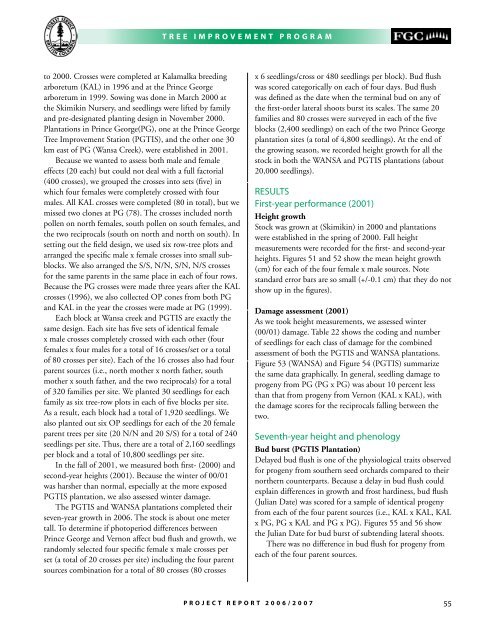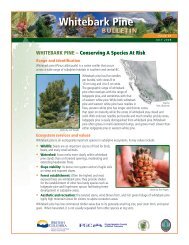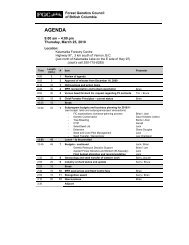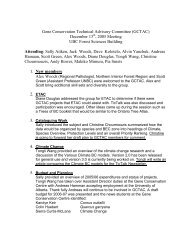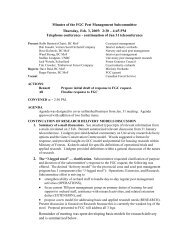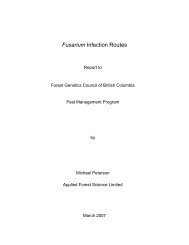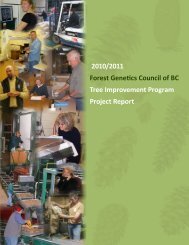Tree Improvement Program Project Report 2006 / 2007
Tree Improvement Program Project Report 2006 / 2007
Tree Improvement Program Project Report 2006 / 2007
Create successful ePaper yourself
Turn your PDF publications into a flip-book with our unique Google optimized e-Paper software.
to 2000. Crosses were completed at Kalamalka breeding<br />
arboretum (KAL) in 1996 and at the Prince George<br />
arboretum in 1999. Sowing was done in March 2000 at<br />
the Skimikin Nursery, and seedlings were lifted by family<br />
and pre-designated planting design in November 2000.<br />
Plantations in Prince George(PG), one at the Prince George<br />
<strong>Tree</strong> <strong>Improvement</strong> Station (PGTIS), and the other one 30<br />
km east of PG (Wansa Creek), were established in 2001.<br />
Because we wanted to assess both male and female<br />
effects (20 each) but could not deal with a full factorial<br />
(400 crosses), we grouped the crosses into sets (five) in<br />
which four females were completely crossed with four<br />
males. All KAL crosses were completed (80 in total), but we<br />
missed two clones at PG (78). The crosses included north<br />
pollen on north females, south pollen on south females, and<br />
the two reciprocals (south on north and north on south). In<br />
setting out the field design, we used six row-tree plots and<br />
arranged the specific male x female crosses into small subblocks.<br />
We also arranged the S/S, N/N, S/N, N/S crosses<br />
for the same parents in the same place in each of four rows.<br />
Because the PG crosses were made three years after the KAL<br />
crosses (1996), we also collected OP cones from both PG<br />
and KAL in the year the crosses were made at PG (1999).<br />
Each block at Wansa creek and PGTIS are exactly the<br />
same design. Each site has five sets of identical female<br />
x male crosses completely crossed with each other (four<br />
females x four males for a total of 16 crosses/set or a total<br />
of 80 crosses per site). Each of the 16 crosses also had four<br />
parent sources (i.e., north mother x north father, south<br />
mother x south father, and the two reciprocals) for a total<br />
of 320 families per site. We planted 30 seedlings for each<br />
family as six tree-row plots in each of five blocks per site.<br />
As a result, each block had a total of 1,920 seedlings. We<br />
also planted out six OP seedlings for each of the 20 female<br />
parent trees per site (20 N/N and 20 S/S) for a total of 240<br />
seedlings per site. Thus, there are a total of 2,160 seedlings<br />
per block and a total of 10,800 seedlings per site.<br />
In the fall of 2001, we measured both first- (2000) and<br />
second-year heights (2001). Because the winter of 00/01<br />
was harsher than normal, especially at the more exposed<br />
PGTIS plantation, we also assessed winter damage.<br />
The PGTIS and WANSA plantations completed their<br />
seven-year growth in <strong>2006</strong>. The stock is about one meter<br />
tall. To determine if photoperiod differences between<br />
Prince George and Vernon affect bud flush and growth, we<br />
randomly selected four specific female x male crosses per<br />
set (a total of 20 crosses per site) including the four parent<br />
sources combination for a total of 80 crosses (80 crosses<br />
T R E E I M P R O V E M E N T P R O G R A M<br />
P R O J E C T R E P O R T 2 0 0 6 / 2 0 0 7<br />
x 6 seedlings/cross or 480 seedlings per block). Bud flush<br />
was scored categorically on each of four days. Bud flush<br />
was defined as the date when the terminal bud on any of<br />
the first-order lateral shoots burst its scales. The same 20<br />
families and 80 crosses were surveyed in each of the five<br />
blocks (2,400 seedlings) on each of the two Prince George<br />
plantation sites (a total of 4,800 seedlings). At the end of<br />
the growing season, we recorded height growth for all the<br />
stock in both the WANSA and PGTIS plantations (about<br />
20,000 seedlings).<br />
RESULTS<br />
F rst-year performance (2001)<br />
Height growth<br />
Stock was grown at (Skimikin) in 2000 and plantations<br />
were established in the spring of 2000. Fall height<br />
measurements were recorded for the first- and second-year<br />
heights. Figures 51 and 52 show the mean height growth<br />
(cm) for each of the four female x male sources. Note<br />
standard error bars are so small (+/-0.1 cm) that they do not<br />
show up in the figures).<br />
Damage assessment (2001)<br />
As we took height measurements, we assessed winter<br />
(00/01) damage. Table 22 shows the coding and number<br />
of seedlings for each class of damage for the combined<br />
assessment of both the PGTIS and WANSA plantations.<br />
Figure 53 (WANSA) and Figure 54 (PGTIS) summarize<br />
the same data graphically. In general, seedling damage to<br />
progeny from PG (PG x PG) was about 10 percent less<br />
than that from progeny from Vernon (KAL x KAL), with<br />
the damage scores for the reciprocals falling between the<br />
two.<br />
Seventh-year he ght and phenology<br />
Bud burst (PGTIS Plantation)<br />
Delayed bud flush is one of the physiological traits observed<br />
for progeny from southern seed orchards compared to their<br />
northern counterparts. Because a delay in bud flush could<br />
explain differences in growth and frost hardiness, bud flush<br />
(Julian Date) was scored for a sample of identical progeny<br />
from each of the four parent sources (i.e., KAL x KAL, KAL<br />
x PG, PG x KAL and PG x PG). Figures 55 and 56 show<br />
the Julian Date for bud burst of subtending lateral shoots.<br />
There was no difference in bud flush for progeny from<br />
each of the four parent sources.


